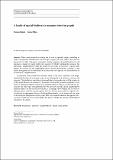Files in this item
A family of spatial biodiversity measures based on graphs
Item metadata
| dc.contributor.author | Rajala, T | |
| dc.contributor.author | Illian, Janine Baerbel | |
| dc.date.accessioned | 2013-02-11T13:01:01Z | |
| dc.date.available | 2013-02-11T13:01:01Z | |
| dc.date.issued | 2012-12 | |
| dc.identifier | 5264729 | |
| dc.identifier | 57d421e5-642d-4d13-ae4a-cfc80f07edba | |
| dc.identifier | 84870369670 | |
| dc.identifier.citation | Rajala , T & Illian , J B 2012 , ' A family of spatial biodiversity measures based on graphs ' , Environmental and Ecological Statistics , vol. 19 , no. 4 , pp. 545-572 . https://doi.org/10.1007/s10651-012-0200-9 | en |
| dc.identifier.issn | 1352-8505 | |
| dc.identifier.uri | https://hdl.handle.net/10023/3350 | |
| dc.description.abstract | While much research in ecology has focused on spatially explicit modelling as well as on measures of biodiversity, the concept of spatial (or local) biodiversity has been discussed very little. This paper generalises existing measures of spatial biodiversity and introduces a family of spatial biodiversity measures by flexibly defining the notion of the individuals’ neighbourhood within the framework of graphs associated to a spatial point pattern. We consider two non-independent aspects of spatial biodiversity, scattering, i.e. the spatial arrangement of the individuals in the study area and exposure, the local diversity in an individual’s neighbourhood. A simulation study reveals that measures based on the most commonly used neigh-bourhood defined by the geometric graph do not distinguish well between scattering and exposure. This problem is much less pronounced when other graphs are used. In an analysis of the spatial diversity in a rainforest, the results based on the geometric graph have been shown to spuriously indicate a decrease in spatial biodiversity when no such trend was detected by the other types of neighbourhoods. We also show that the choice neighbourhood markedly impacts on the classification of species according to how strongly and in what way different species spatially structure species diversity. Clearly, in an analysis of spatial or local diversity an appropriate choice of local neighbourhood is crucial in particular in terms of the biological interpretation of the results. Due to its general definition, the approach discussed here offers the necessary flexibility that allows suitable and varying neighbourhood structures to be chosen. | |
| dc.format.extent | 28 | |
| dc.format.extent | 201861 | |
| dc.language.iso | eng | |
| dc.relation.ispartof | Environmental and Ecological Statistics | en |
| dc.subject | Biodiversity | en |
| dc.subject | Exposure | en |
| dc.subject | Neighbourhood | en |
| dc.subject | Spatial | en |
| dc.subject | Point pattern | en |
| dc.subject | QA Mathematics | en |
| dc.subject.lcc | QA | en |
| dc.title | A family of spatial biodiversity measures based on graphs | en |
| dc.type | Journal article | en |
| dc.contributor.institution | University of St Andrews. School of Mathematics and Statistics | en |
| dc.contributor.institution | University of St Andrews. Scottish Oceans Institute | en |
| dc.contributor.institution | University of St Andrews. Centre for Research into Ecological & Environmental Modelling | en |
| dc.identifier.doi | 10.1007/s10651-012-0200-9 | |
| dc.description.status | Peer reviewed | en |
This item appears in the following Collection(s)
Items in the St Andrews Research Repository are protected by copyright, with all rights reserved, unless otherwise indicated.

